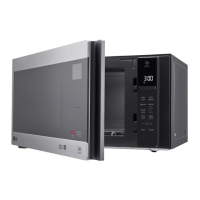14
MICROWAVE COOKING TIPS
Cooking Guide
Cooking with your new oven offers a wide variety of
food preparation options: microwave cooking.
Microwave cooking uses very short, high-frequency
radio waves. The movement of the microwaves
through the food generates heat and cooks most
foods faster than regular methods, while retaining
their natural texture and moisture. Microwave cooking
heats food directly, not the cookware or the interior
of the oven. Reheating is easy and defrosting is
particularly convenient because less time is spent in
food preparation.
Microwave
Cooking Method
Microwave energy
is distributed evenly
throughout the oven for
fast, thorough cooking of
food.
Heat Source Microwave energy.
Benefits
•
Fast, high efficiency
cooking.
•
Oven and surroundings
do not get hot.
•
Easy clean-up
Cookware Guide
Microwave Cooking
Most heat-resistant, non-metallic cookware is safe for
use in the microwave oven.
Testing Cookware Before Using
1
Place the empty cookware in the microwave
oven.
2
Measure 1 cup of water in a glass measuring cup
and place it in the oven beside the cookware.
3
Microwave on 100% power for 1 minute. If
the dish is warm, it should not be used for
microwave cooking.
Cookware Microwave
Heat-Resistant Glass,
Ceramic Glass
Yes
Ceramics, China Yes
(Do not use china
with gold or silver
trim.)
Metal Cookware No
Non Heat-Resistant Glass No
Microwave-Safe Plastic Yes
Plastic Wrap, Wax Paper Yes
Paper Products Yes
Straw, Wicker, and Wood Yes
* Use only microwave cookware that is safe to 450°F
NOTE
•
NEVER operate the microwave mode while the
oven is empty.

